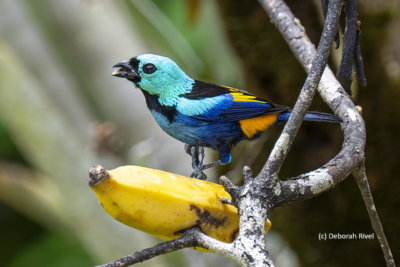
The Atlantic Forest of northern South America is one of the world’s most endangered habitats. The forest at what is now RPPN Pedra D’Antas had once been heavily degraded—cleared almost entirely for agriculture. But in northeast Brazil, over 350 hectares have been successfully rewilded thanks to the efforts of BirdLife International’s partner, SAVE Brasil. When the restoration began eight years ago, only a handful of common bird species remained. Today, over 150 species thrive here—including some critically endangered birds native to the Atlantic Forest. I recently had the chance to visit this remarkable site.
Located about 180 km from Recife, this lush reserve is now one of the few places where you can spot rare species like this dazzling Seven-colored Tanager. Around the open-air event space, feeders for hummingbirds and tanagers draw a flurry of activity, offering visitors a close-up view of the forest’s avian diversity—and enhancing both education and fundraising efforts. The soft hum of jacobins and hermits flitting between flowers forms a constant natural soundtrack.
Biodiversity bursts from every corner: tiny blue, fuzzy spiders hide in bromeliads; Blue Morpho butterflies and Black Witch moths drift through the trees; marmosets visit the banana feeders, and giant Cane Toads emerge at night. Even lightning bugs—vanishing from so many places—have begun to return. Every walk through these tree-covered pathways resonates with wildlife and birdsong.
When this land was first acquired, it had been pushed to the brink by decades of agriculture. Once rich with the biodiversity of the Atlantic Forest, it had been reduced to barren soil. After multiple crop cycles failed and even sheep could no longer graze, the landscape stood as a lifeless remnant of what once was—dusty ground, a few scattered trees offering faint shade, no undergrowth, and little hope. That began to change when Pedro Develey, Executive Director of SAVE Brasil, stepped in. Working collaboratively with local landowners, communities, and businesses, he helped secure access to the land for an ambitious rewilding project.
Rewildling a piece of property like this takes planning, precision, hard work and finances. Using only native trees and plants which would have been found in the original forest, planting them in a random-esque manner and in a proportion to what they might have been found in originally, the dedicated team tended the plantings – weeding out many invasive plants and treasuring the native Atlantic Forest growth which began to thrive.
After a few years, the property started to resemble the rich habitat it had once been. Birds, reptiles, insects, mammals and amphibians began reclaiming their old home. And within 8 years the reserve is difficult to distinguish from a fully mature Atlantic Forest. With over 150 species of birds now seen here – up from just 9 as the rewilding plans started – this increasingly biodiverse patch of rewilded Atlantic Forest is an excellent example of the resilience of nature when given the chance.
Today, tourists visit to admire the vibrant birdlife, and the park has become a regular destination for local school field trips. Communities benefit from tax incentives and government support simply for allowing this land to be rewilded within their township. SAVE Brasil remains committed to preserving the property in its natural state, a task that demands ongoing care to protect it from invasive species, poaching, and numerous other threats. Yet the lush forest and enchanting birdsong bring a sense of wonder and renewal to the region. Many of the bird species here are endemic to the Atlantic Forest—an ecosystem that is vanishing at an alarming rate. How wonderful that this small pocket of it has been brought back to life.
For more information on SAVE Brasil and their projects.
Visit them on Instagram